Analysis of Play in Early Childhood Development - Language & Learning
VerifiedAdded on 2023/06/15
|14
|3565
|300
Report
AI Summary
This report examines the significance of play in early childhood development, particularly for children aged 2 to 6. It discusses the implications of depriving children of play opportunities, highlighting the impact on social skills, emotional responses, creativity, and language development. The report emphasizes the importance of meeting the needs of children in play-based learning environments, exploring the educator's role in supporting this process. It also delves into diverse views on play in education, the interrelationships with language development, typical and atypical development, and the image of the child as a learner, reflecting on a holistic view of child development in early childhood settings. The report concludes that play is crucial for cognitive processes, skill development, and overall well-being, advocating for attractive and spacious play areas to foster social, imaginative, and creative growth.

Running head: EARLY CHILDHOOD DEVELOPMENT
Early Childhood Development
Name of the Student
Name of the University
Author Note:
Early Childhood Development
Name of the Student
Name of the University
Author Note:
Paraphrase This Document
Need a fresh take? Get an instant paraphrase of this document with our AI Paraphraser
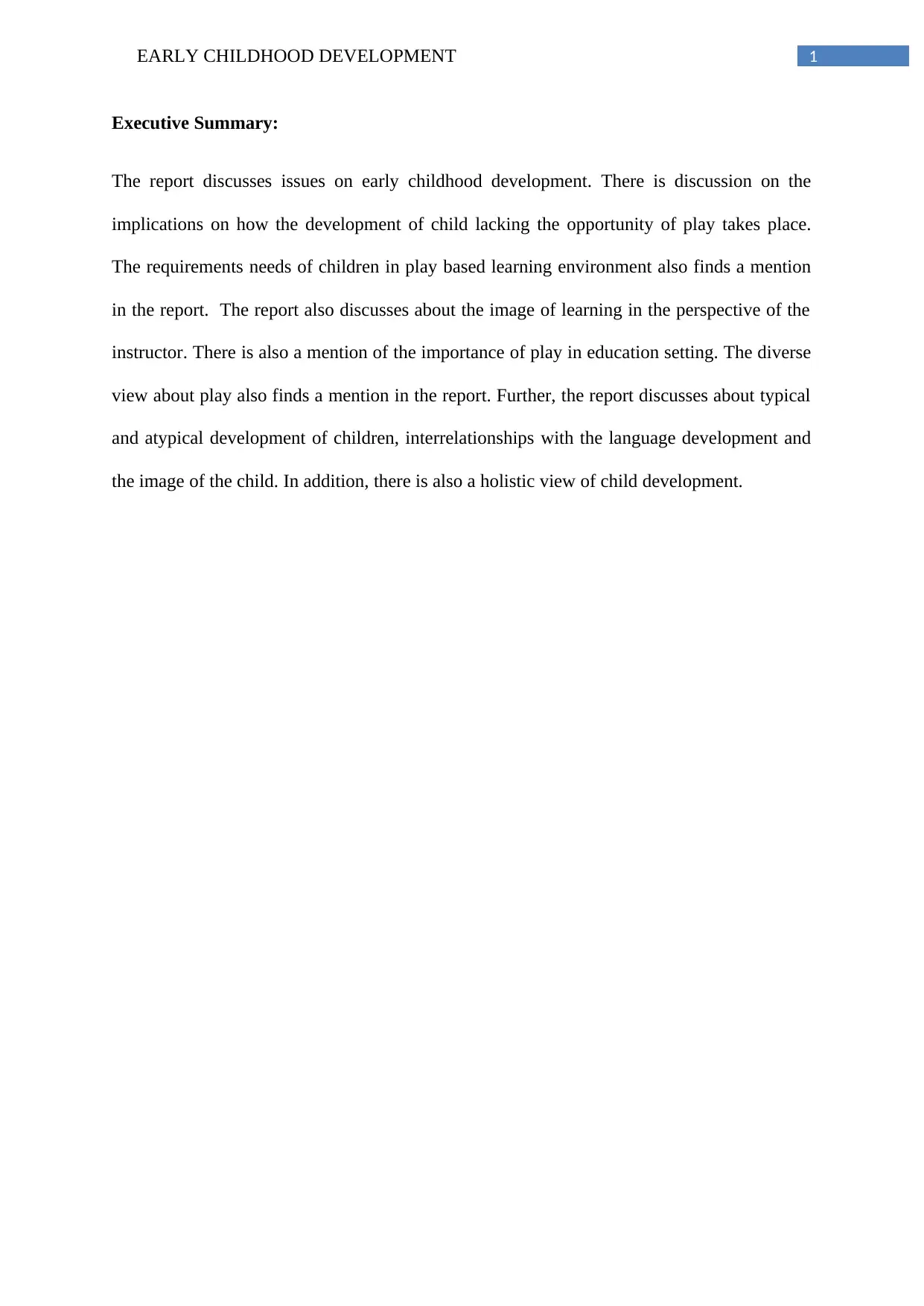
1EARLY CHILDHOOD DEVELOPMENT
Executive Summary:
The report discusses issues on early childhood development. There is discussion on the
implications on how the development of child lacking the opportunity of play takes place.
The requirements needs of children in play based learning environment also finds a mention
in the report. The report also discusses about the image of learning in the perspective of the
instructor. There is also a mention of the importance of play in education setting. The diverse
view about play also finds a mention in the report. Further, the report discusses about typical
and atypical development of children, interrelationships with the language development and
the image of the child. In addition, there is also a holistic view of child development.
Executive Summary:
The report discusses issues on early childhood development. There is discussion on the
implications on how the development of child lacking the opportunity of play takes place.
The requirements needs of children in play based learning environment also finds a mention
in the report. The report also discusses about the image of learning in the perspective of the
instructor. There is also a mention of the importance of play in education setting. The diverse
view about play also finds a mention in the report. Further, the report discusses about typical
and atypical development of children, interrelationships with the language development and
the image of the child. In addition, there is also a holistic view of child development.
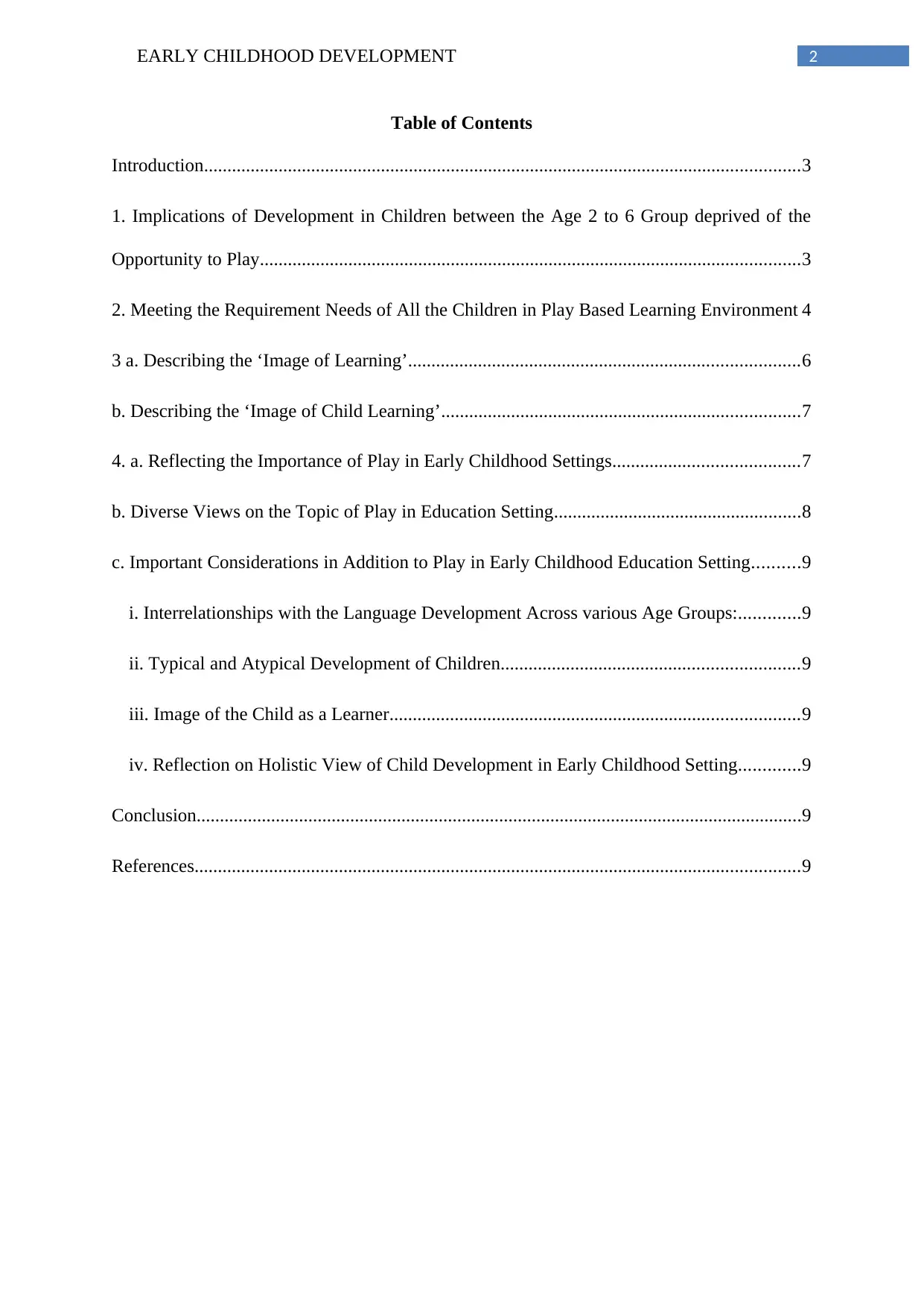
2EARLY CHILDHOOD DEVELOPMENT
Table of Contents
Introduction................................................................................................................................3
1. Implications of Development in Children between the Age 2 to 6 Group deprived of the
Opportunity to Play....................................................................................................................3
2. Meeting the Requirement Needs of All the Children in Play Based Learning Environment 4
3 a. Describing the ‘Image of Learning’....................................................................................6
b. Describing the ‘Image of Child Learning’.............................................................................7
4. a. Reflecting the Importance of Play in Early Childhood Settings........................................7
b. Diverse Views on the Topic of Play in Education Setting.....................................................8
c. Important Considerations in Addition to Play in Early Childhood Education Setting..........9
i. Interrelationships with the Language Development Across various Age Groups:.............9
ii. Typical and Atypical Development of Children................................................................9
iii. Image of the Child as a Learner........................................................................................9
iv. Reflection on Holistic View of Child Development in Early Childhood Setting.............9
Conclusion..................................................................................................................................9
References..................................................................................................................................9
Table of Contents
Introduction................................................................................................................................3
1. Implications of Development in Children between the Age 2 to 6 Group deprived of the
Opportunity to Play....................................................................................................................3
2. Meeting the Requirement Needs of All the Children in Play Based Learning Environment 4
3 a. Describing the ‘Image of Learning’....................................................................................6
b. Describing the ‘Image of Child Learning’.............................................................................7
4. a. Reflecting the Importance of Play in Early Childhood Settings........................................7
b. Diverse Views on the Topic of Play in Education Setting.....................................................8
c. Important Considerations in Addition to Play in Early Childhood Education Setting..........9
i. Interrelationships with the Language Development Across various Age Groups:.............9
ii. Typical and Atypical Development of Children................................................................9
iii. Image of the Child as a Learner........................................................................................9
iv. Reflection on Holistic View of Child Development in Early Childhood Setting.............9
Conclusion..................................................................................................................................9
References..................................................................................................................................9
⊘ This is a preview!⊘
Do you want full access?
Subscribe today to unlock all pages.

Trusted by 1+ million students worldwide
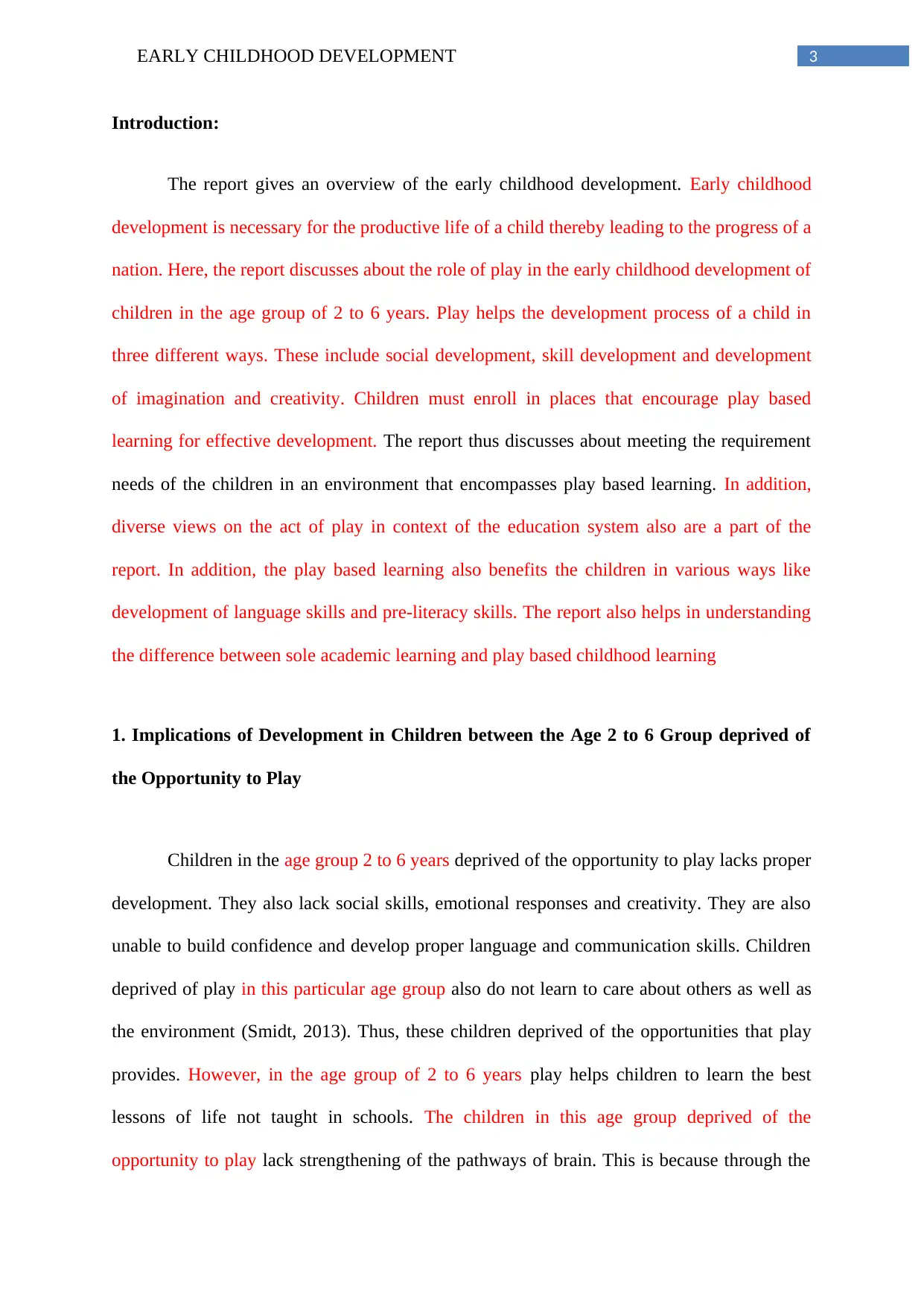
3EARLY CHILDHOOD DEVELOPMENT
Introduction:
The report gives an overview of the early childhood development. Early childhood
development is necessary for the productive life of a child thereby leading to the progress of a
nation. Here, the report discusses about the role of play in the early childhood development of
children in the age group of 2 to 6 years. Play helps the development process of a child in
three different ways. These include social development, skill development and development
of imagination and creativity. Children must enroll in places that encourage play based
learning for effective development. The report thus discusses about meeting the requirement
needs of the children in an environment that encompasses play based learning. In addition,
diverse views on the act of play in context of the education system also are a part of the
report. In addition, the play based learning also benefits the children in various ways like
development of language skills and pre-literacy skills. The report also helps in understanding
the difference between sole academic learning and play based childhood learning
1. Implications of Development in Children between the Age 2 to 6 Group deprived of
the Opportunity to Play
Children in the age group 2 to 6 years deprived of the opportunity to play lacks proper
development. They also lack social skills, emotional responses and creativity. They are also
unable to build confidence and develop proper language and communication skills. Children
deprived of play in this particular age group also do not learn to care about others as well as
the environment (Smidt, 2013). Thus, these children deprived of the opportunities that play
provides. However, in the age group of 2 to 6 years play helps children to learn the best
lessons of life not taught in schools. The children in this age group deprived of the
opportunity to play lack strengthening of the pathways of brain. This is because through the
Introduction:
The report gives an overview of the early childhood development. Early childhood
development is necessary for the productive life of a child thereby leading to the progress of a
nation. Here, the report discusses about the role of play in the early childhood development of
children in the age group of 2 to 6 years. Play helps the development process of a child in
three different ways. These include social development, skill development and development
of imagination and creativity. Children must enroll in places that encourage play based
learning for effective development. The report thus discusses about meeting the requirement
needs of the children in an environment that encompasses play based learning. In addition,
diverse views on the act of play in context of the education system also are a part of the
report. In addition, the play based learning also benefits the children in various ways like
development of language skills and pre-literacy skills. The report also helps in understanding
the difference between sole academic learning and play based childhood learning
1. Implications of Development in Children between the Age 2 to 6 Group deprived of
the Opportunity to Play
Children in the age group 2 to 6 years deprived of the opportunity to play lacks proper
development. They also lack social skills, emotional responses and creativity. They are also
unable to build confidence and develop proper language and communication skills. Children
deprived of play in this particular age group also do not learn to care about others as well as
the environment (Smidt, 2013). Thus, these children deprived of the opportunities that play
provides. However, in the age group of 2 to 6 years play helps children to learn the best
lessons of life not taught in schools. The children in this age group deprived of the
opportunity to play lack strengthening of the pathways of brain. This is because through the
Paraphrase This Document
Need a fresh take? Get an instant paraphrase of this document with our AI Paraphraser
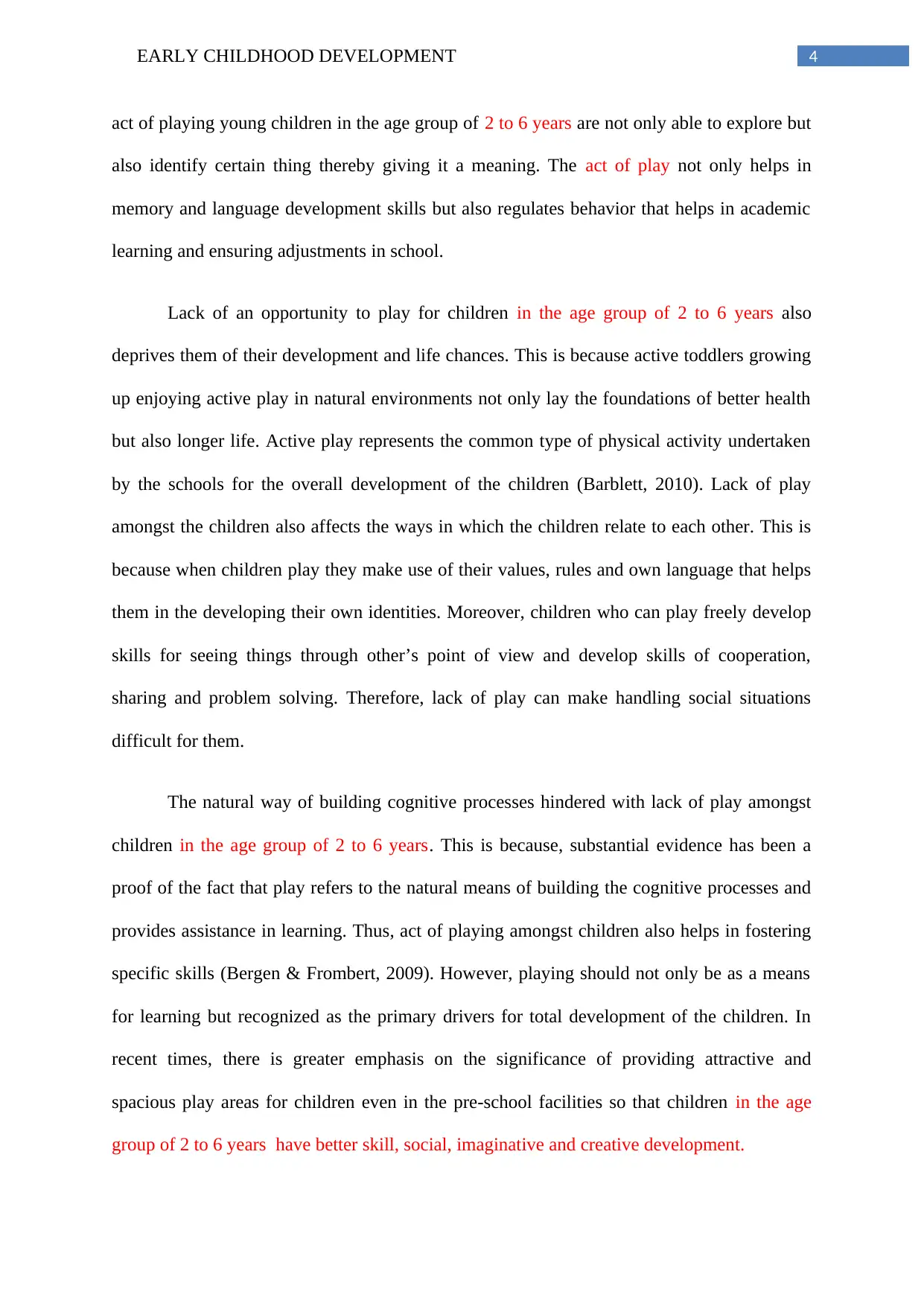
4EARLY CHILDHOOD DEVELOPMENT
act of playing young children in the age group of 2 to 6 years are not only able to explore but
also identify certain thing thereby giving it a meaning. The act of play not only helps in
memory and language development skills but also regulates behavior that helps in academic
learning and ensuring adjustments in school.
Lack of an opportunity to play for children in the age group of 2 to 6 years also
deprives them of their development and life chances. This is because active toddlers growing
up enjoying active play in natural environments not only lay the foundations of better health
but also longer life. Active play represents the common type of physical activity undertaken
by the schools for the overall development of the children (Barblett, 2010). Lack of play
amongst the children also affects the ways in which the children relate to each other. This is
because when children play they make use of their values, rules and own language that helps
them in the developing their own identities. Moreover, children who can play freely develop
skills for seeing things through other’s point of view and develop skills of cooperation,
sharing and problem solving. Therefore, lack of play can make handling social situations
difficult for them.
The natural way of building cognitive processes hindered with lack of play amongst
children in the age group of 2 to 6 years. This is because, substantial evidence has been a
proof of the fact that play refers to the natural means of building the cognitive processes and
provides assistance in learning. Thus, act of playing amongst children also helps in fostering
specific skills (Bergen & Frombert, 2009). However, playing should not only be as a means
for learning but recognized as the primary drivers for total development of the children. In
recent times, there is greater emphasis on the significance of providing attractive and
spacious play areas for children even in the pre-school facilities so that children in the age
group of 2 to 6 years have better skill, social, imaginative and creative development.
act of playing young children in the age group of 2 to 6 years are not only able to explore but
also identify certain thing thereby giving it a meaning. The act of play not only helps in
memory and language development skills but also regulates behavior that helps in academic
learning and ensuring adjustments in school.
Lack of an opportunity to play for children in the age group of 2 to 6 years also
deprives them of their development and life chances. This is because active toddlers growing
up enjoying active play in natural environments not only lay the foundations of better health
but also longer life. Active play represents the common type of physical activity undertaken
by the schools for the overall development of the children (Barblett, 2010). Lack of play
amongst the children also affects the ways in which the children relate to each other. This is
because when children play they make use of their values, rules and own language that helps
them in the developing their own identities. Moreover, children who can play freely develop
skills for seeing things through other’s point of view and develop skills of cooperation,
sharing and problem solving. Therefore, lack of play can make handling social situations
difficult for them.
The natural way of building cognitive processes hindered with lack of play amongst
children in the age group of 2 to 6 years. This is because, substantial evidence has been a
proof of the fact that play refers to the natural means of building the cognitive processes and
provides assistance in learning. Thus, act of playing amongst children also helps in fostering
specific skills (Bergen & Frombert, 2009). However, playing should not only be as a means
for learning but recognized as the primary drivers for total development of the children. In
recent times, there is greater emphasis on the significance of providing attractive and
spacious play areas for children even in the pre-school facilities so that children in the age
group of 2 to 6 years have better skill, social, imaginative and creative development.
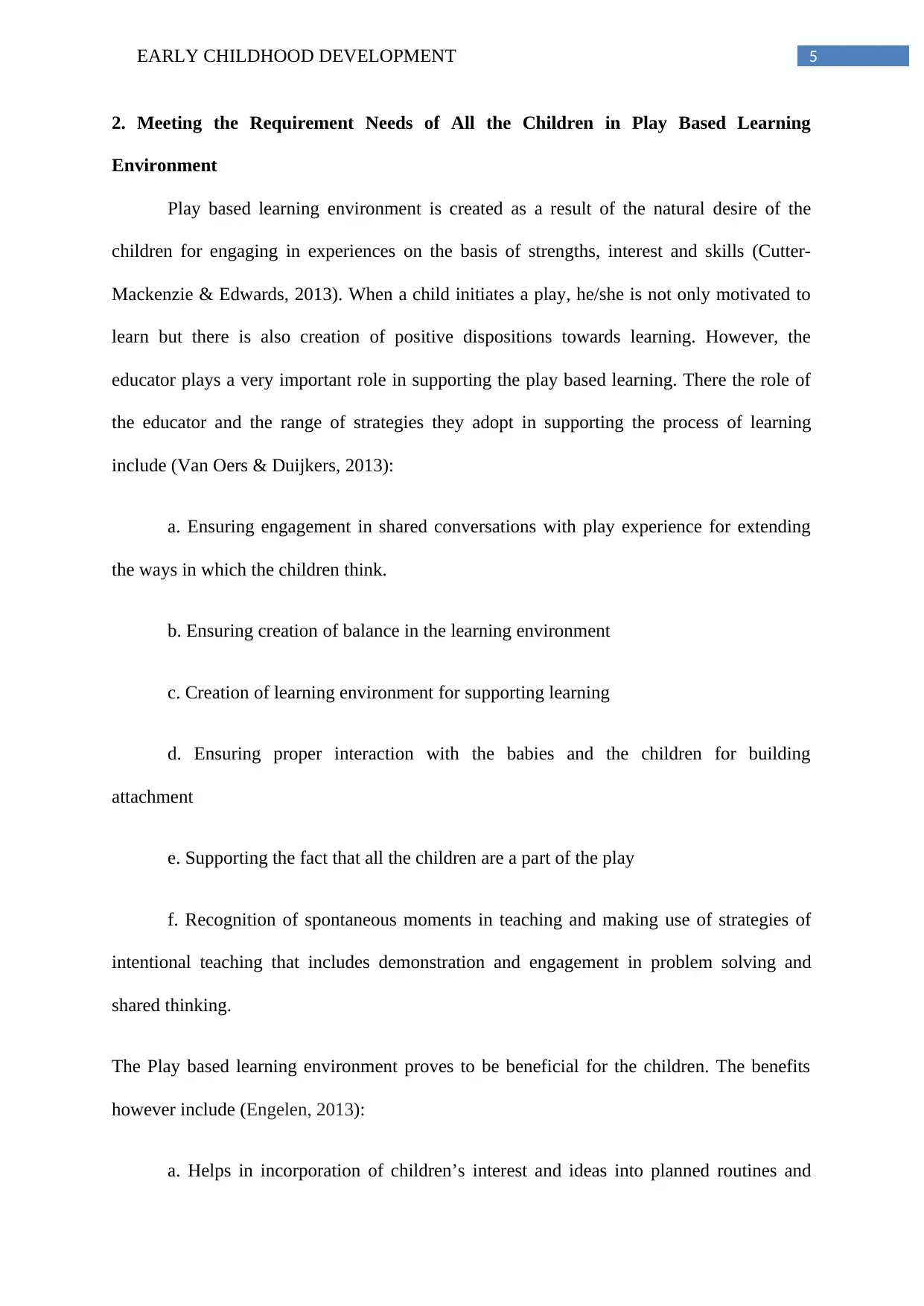
5EARLY CHILDHOOD DEVELOPMENT
2. Meeting the Requirement Needs of All the Children in Play Based Learning
Environment
Play based learning environment is created as a result of the natural desire of the
children for engaging in experiences on the basis of strengths, interest and skills (Cutter-
Mackenzie & Edwards, 2013). When a child initiates a play, he/she is not only motivated to
learn but there is also creation of positive dispositions towards learning. However, the
educator plays a very important role in supporting the play based learning. There the role of
the educator and the range of strategies they adopt in supporting the process of learning
include (Van Oers & Duijkers, 2013):
a. Ensuring engagement in shared conversations with play experience for extending
the ways in which the children think.
b. Ensuring creation of balance in the learning environment
c. Creation of learning environment for supporting learning
d. Ensuring proper interaction with the babies and the children for building
attachment
e. Supporting the fact that all the children are a part of the play
f. Recognition of spontaneous moments in teaching and making use of strategies of
intentional teaching that includes demonstration and engagement in problem solving and
shared thinking.
The Play based learning environment proves to be beneficial for the children. The benefits
however include (Engelen, 2013):
a. Helps in incorporation of children’s interest and ideas into planned routines and
2. Meeting the Requirement Needs of All the Children in Play Based Learning
Environment
Play based learning environment is created as a result of the natural desire of the
children for engaging in experiences on the basis of strengths, interest and skills (Cutter-
Mackenzie & Edwards, 2013). When a child initiates a play, he/she is not only motivated to
learn but there is also creation of positive dispositions towards learning. However, the
educator plays a very important role in supporting the play based learning. There the role of
the educator and the range of strategies they adopt in supporting the process of learning
include (Van Oers & Duijkers, 2013):
a. Ensuring engagement in shared conversations with play experience for extending
the ways in which the children think.
b. Ensuring creation of balance in the learning environment
c. Creation of learning environment for supporting learning
d. Ensuring proper interaction with the babies and the children for building
attachment
e. Supporting the fact that all the children are a part of the play
f. Recognition of spontaneous moments in teaching and making use of strategies of
intentional teaching that includes demonstration and engagement in problem solving and
shared thinking.
The Play based learning environment proves to be beneficial for the children. The benefits
however include (Engelen, 2013):
a. Helps in incorporation of children’s interest and ideas into planned routines and
⊘ This is a preview!⊘
Do you want full access?
Subscribe today to unlock all pages.

Trusted by 1+ million students worldwide
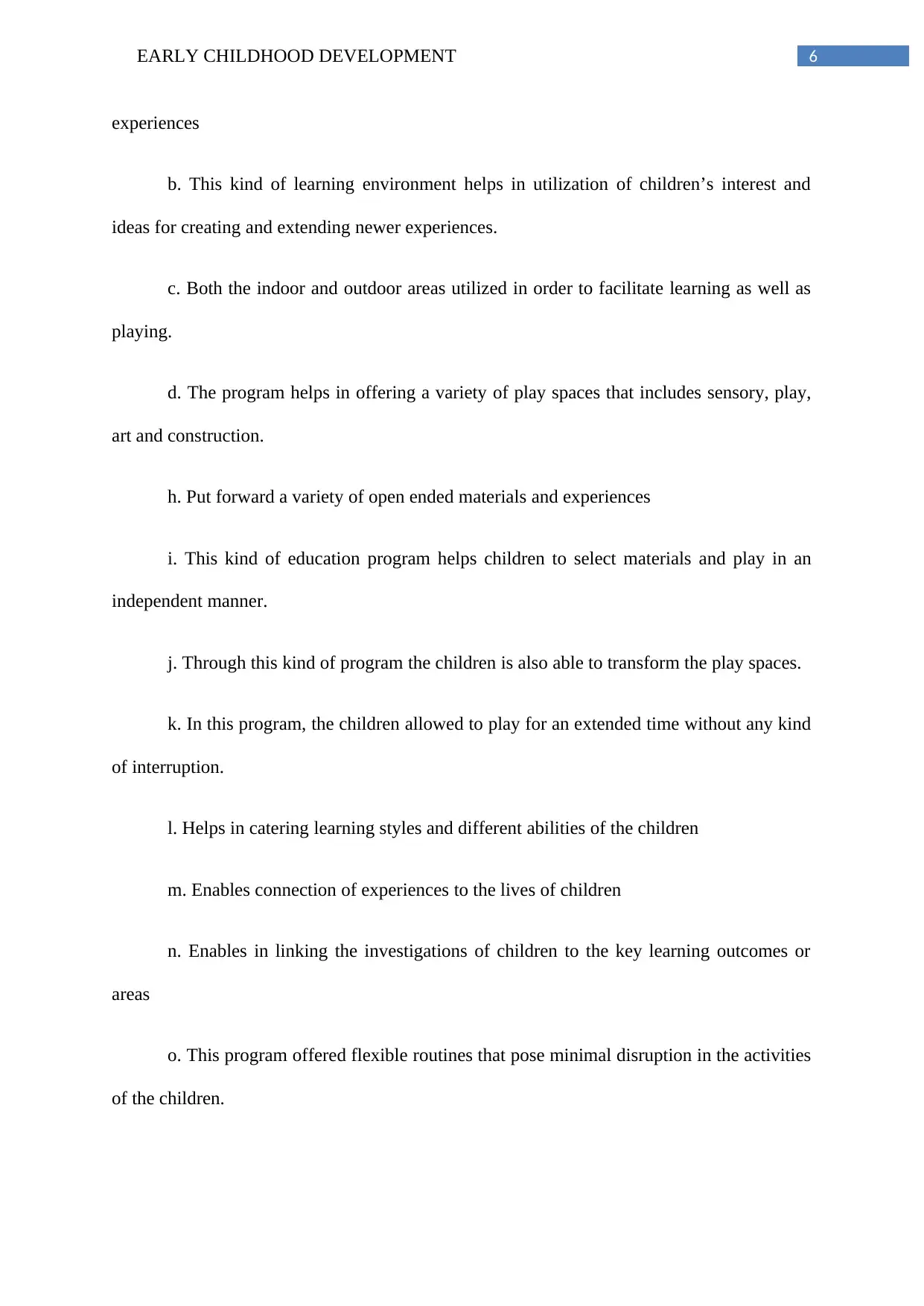
6EARLY CHILDHOOD DEVELOPMENT
experiences
b. This kind of learning environment helps in utilization of children’s interest and
ideas for creating and extending newer experiences.
c. Both the indoor and outdoor areas utilized in order to facilitate learning as well as
playing.
d. The program helps in offering a variety of play spaces that includes sensory, play,
art and construction.
h. Put forward a variety of open ended materials and experiences
i. This kind of education program helps children to select materials and play in an
independent manner.
j. Through this kind of program the children is also able to transform the play spaces.
k. In this program, the children allowed to play for an extended time without any kind
of interruption.
l. Helps in catering learning styles and different abilities of the children
m. Enables connection of experiences to the lives of children
n. Enables in linking the investigations of children to the key learning outcomes or
areas
o. This program offered flexible routines that pose minimal disruption in the activities
of the children.
experiences
b. This kind of learning environment helps in utilization of children’s interest and
ideas for creating and extending newer experiences.
c. Both the indoor and outdoor areas utilized in order to facilitate learning as well as
playing.
d. The program helps in offering a variety of play spaces that includes sensory, play,
art and construction.
h. Put forward a variety of open ended materials and experiences
i. This kind of education program helps children to select materials and play in an
independent manner.
j. Through this kind of program the children is also able to transform the play spaces.
k. In this program, the children allowed to play for an extended time without any kind
of interruption.
l. Helps in catering learning styles and different abilities of the children
m. Enables connection of experiences to the lives of children
n. Enables in linking the investigations of children to the key learning outcomes or
areas
o. This program offered flexible routines that pose minimal disruption in the activities
of the children.
Paraphrase This Document
Need a fresh take? Get an instant paraphrase of this document with our AI Paraphraser
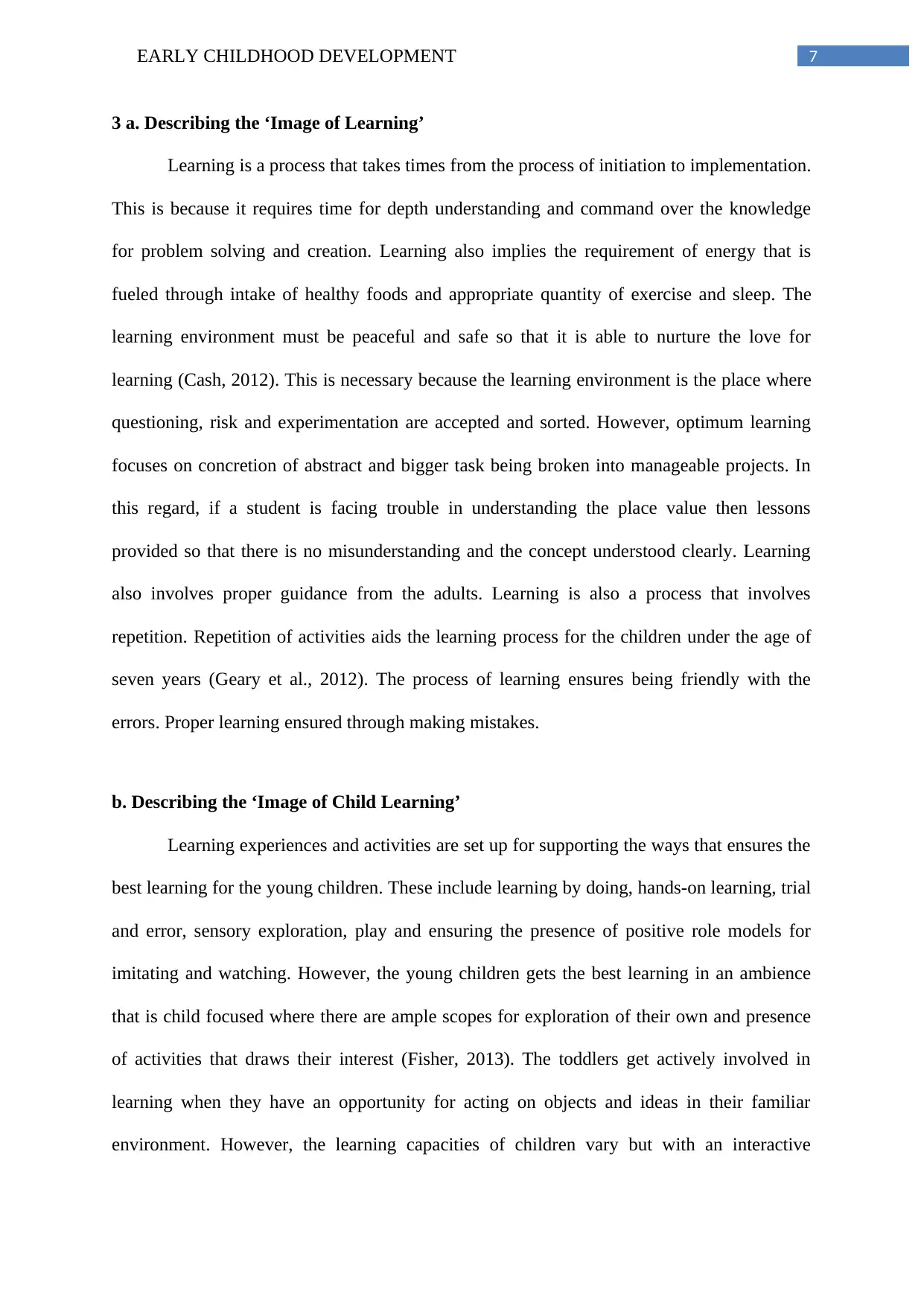
7EARLY CHILDHOOD DEVELOPMENT
3 a. Describing the ‘Image of Learning’
Learning is a process that takes times from the process of initiation to implementation.
This is because it requires time for depth understanding and command over the knowledge
for problem solving and creation. Learning also implies the requirement of energy that is
fueled through intake of healthy foods and appropriate quantity of exercise and sleep. The
learning environment must be peaceful and safe so that it is able to nurture the love for
learning (Cash, 2012). This is necessary because the learning environment is the place where
questioning, risk and experimentation are accepted and sorted. However, optimum learning
focuses on concretion of abstract and bigger task being broken into manageable projects. In
this regard, if a student is facing trouble in understanding the place value then lessons
provided so that there is no misunderstanding and the concept understood clearly. Learning
also involves proper guidance from the adults. Learning is also a process that involves
repetition. Repetition of activities aids the learning process for the children under the age of
seven years (Geary et al., 2012). The process of learning ensures being friendly with the
errors. Proper learning ensured through making mistakes.
b. Describing the ‘Image of Child Learning’
Learning experiences and activities are set up for supporting the ways that ensures the
best learning for the young children. These include learning by doing, hands-on learning, trial
and error, sensory exploration, play and ensuring the presence of positive role models for
imitating and watching. However, the young children gets the best learning in an ambience
that is child focused where there are ample scopes for exploration of their own and presence
of activities that draws their interest (Fisher, 2013). The toddlers get actively involved in
learning when they have an opportunity for acting on objects and ideas in their familiar
environment. However, the learning capacities of children vary but with an interactive
3 a. Describing the ‘Image of Learning’
Learning is a process that takes times from the process of initiation to implementation.
This is because it requires time for depth understanding and command over the knowledge
for problem solving and creation. Learning also implies the requirement of energy that is
fueled through intake of healthy foods and appropriate quantity of exercise and sleep. The
learning environment must be peaceful and safe so that it is able to nurture the love for
learning (Cash, 2012). This is necessary because the learning environment is the place where
questioning, risk and experimentation are accepted and sorted. However, optimum learning
focuses on concretion of abstract and bigger task being broken into manageable projects. In
this regard, if a student is facing trouble in understanding the place value then lessons
provided so that there is no misunderstanding and the concept understood clearly. Learning
also involves proper guidance from the adults. Learning is also a process that involves
repetition. Repetition of activities aids the learning process for the children under the age of
seven years (Geary et al., 2012). The process of learning ensures being friendly with the
errors. Proper learning ensured through making mistakes.
b. Describing the ‘Image of Child Learning’
Learning experiences and activities are set up for supporting the ways that ensures the
best learning for the young children. These include learning by doing, hands-on learning, trial
and error, sensory exploration, play and ensuring the presence of positive role models for
imitating and watching. However, the young children gets the best learning in an ambience
that is child focused where there are ample scopes for exploration of their own and presence
of activities that draws their interest (Fisher, 2013). The toddlers get actively involved in
learning when they have an opportunity for acting on objects and ideas in their familiar
environment. However, the learning capacities of children vary but with an interactive
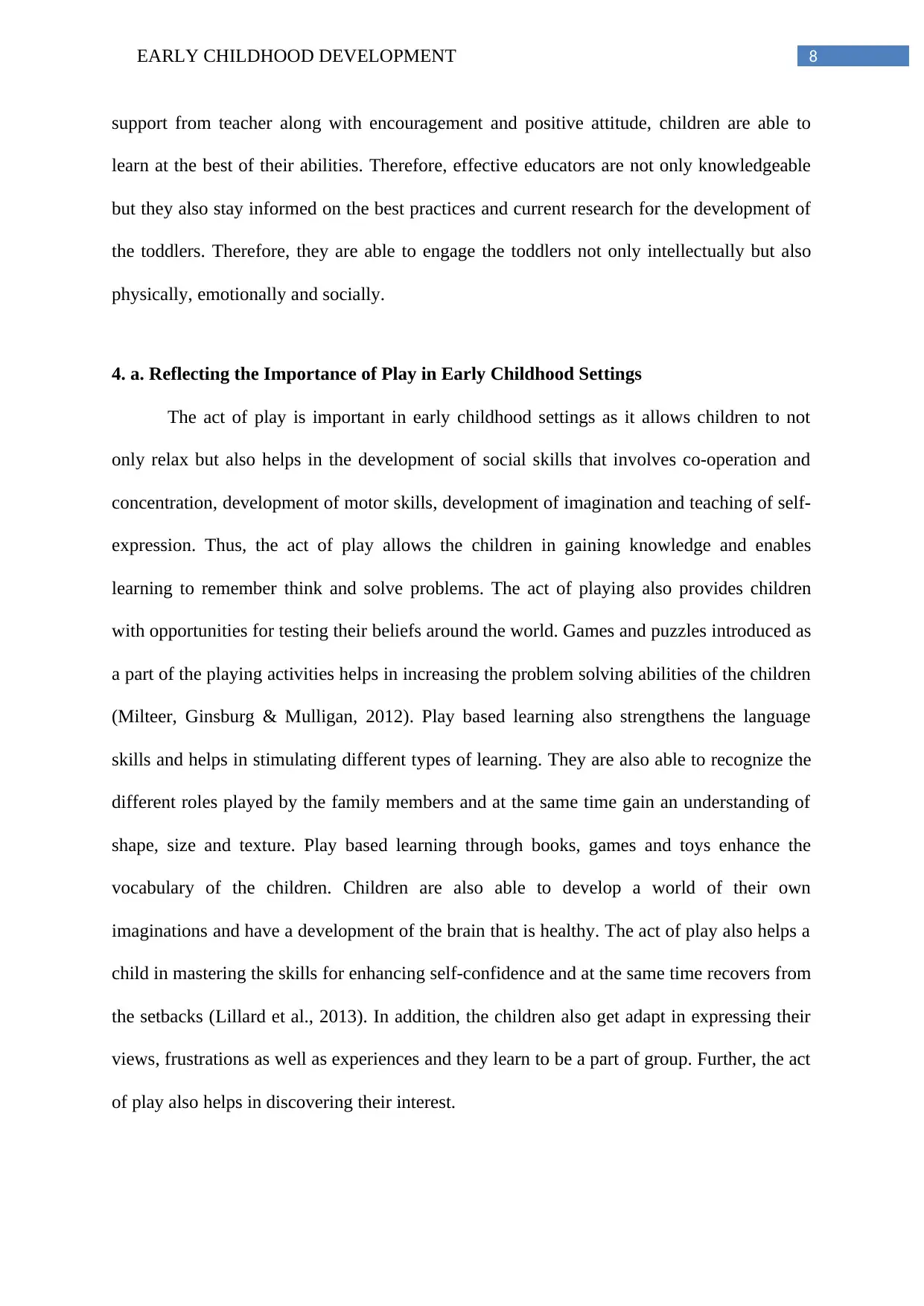
8EARLY CHILDHOOD DEVELOPMENT
support from teacher along with encouragement and positive attitude, children are able to
learn at the best of their abilities. Therefore, effective educators are not only knowledgeable
but they also stay informed on the best practices and current research for the development of
the toddlers. Therefore, they are able to engage the toddlers not only intellectually but also
physically, emotionally and socially.
4. a. Reflecting the Importance of Play in Early Childhood Settings
The act of play is important in early childhood settings as it allows children to not
only relax but also helps in the development of social skills that involves co-operation and
concentration, development of motor skills, development of imagination and teaching of self-
expression. Thus, the act of play allows the children in gaining knowledge and enables
learning to remember think and solve problems. The act of playing also provides children
with opportunities for testing their beliefs around the world. Games and puzzles introduced as
a part of the playing activities helps in increasing the problem solving abilities of the children
(Milteer, Ginsburg & Mulligan, 2012). Play based learning also strengthens the language
skills and helps in stimulating different types of learning. They are also able to recognize the
different roles played by the family members and at the same time gain an understanding of
shape, size and texture. Play based learning through books, games and toys enhance the
vocabulary of the children. Children are also able to develop a world of their own
imaginations and have a development of the brain that is healthy. The act of play also helps a
child in mastering the skills for enhancing self-confidence and at the same time recovers from
the setbacks (Lillard et al., 2013). In addition, the children also get adapt in expressing their
views, frustrations as well as experiences and they learn to be a part of group. Further, the act
of play also helps in discovering their interest.
support from teacher along with encouragement and positive attitude, children are able to
learn at the best of their abilities. Therefore, effective educators are not only knowledgeable
but they also stay informed on the best practices and current research for the development of
the toddlers. Therefore, they are able to engage the toddlers not only intellectually but also
physically, emotionally and socially.
4. a. Reflecting the Importance of Play in Early Childhood Settings
The act of play is important in early childhood settings as it allows children to not
only relax but also helps in the development of social skills that involves co-operation and
concentration, development of motor skills, development of imagination and teaching of self-
expression. Thus, the act of play allows the children in gaining knowledge and enables
learning to remember think and solve problems. The act of playing also provides children
with opportunities for testing their beliefs around the world. Games and puzzles introduced as
a part of the playing activities helps in increasing the problem solving abilities of the children
(Milteer, Ginsburg & Mulligan, 2012). Play based learning also strengthens the language
skills and helps in stimulating different types of learning. They are also able to recognize the
different roles played by the family members and at the same time gain an understanding of
shape, size and texture. Play based learning through books, games and toys enhance the
vocabulary of the children. Children are also able to develop a world of their own
imaginations and have a development of the brain that is healthy. The act of play also helps a
child in mastering the skills for enhancing self-confidence and at the same time recovers from
the setbacks (Lillard et al., 2013). In addition, the children also get adapt in expressing their
views, frustrations as well as experiences and they learn to be a part of group. Further, the act
of play also helps in discovering their interest.
⊘ This is a preview!⊘
Do you want full access?
Subscribe today to unlock all pages.

Trusted by 1+ million students worldwide
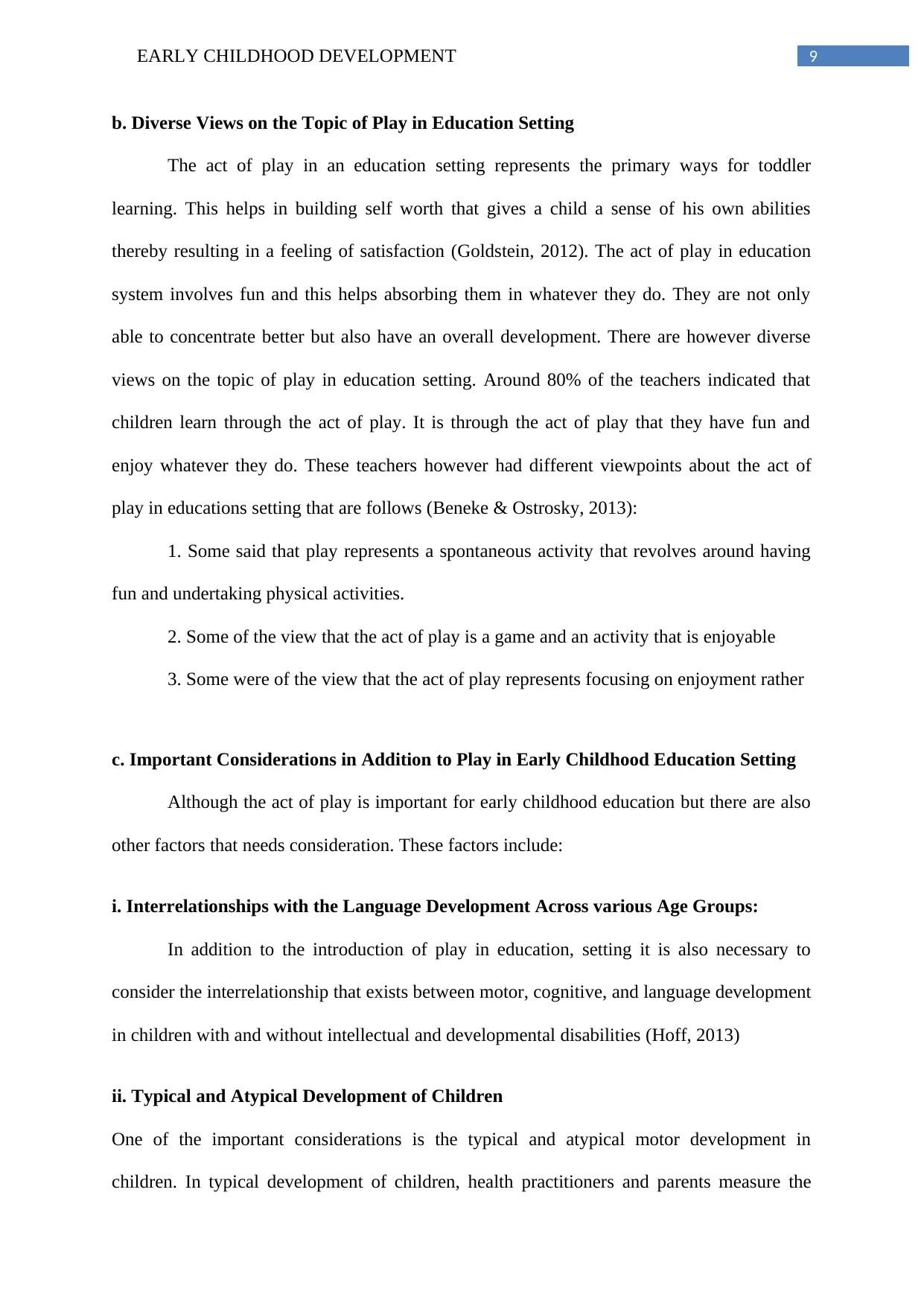
9EARLY CHILDHOOD DEVELOPMENT
b. Diverse Views on the Topic of Play in Education Setting
The act of play in an education setting represents the primary ways for toddler
learning. This helps in building self worth that gives a child a sense of his own abilities
thereby resulting in a feeling of satisfaction (Goldstein, 2012). The act of play in education
system involves fun and this helps absorbing them in whatever they do. They are not only
able to concentrate better but also have an overall development. There are however diverse
views on the topic of play in education setting. Around 80% of the teachers indicated that
children learn through the act of play. It is through the act of play that they have fun and
enjoy whatever they do. These teachers however had different viewpoints about the act of
play in educations setting that are follows (Beneke & Ostrosky, 2013):
1. Some said that play represents a spontaneous activity that revolves around having
fun and undertaking physical activities.
2. Some of the view that the act of play is a game and an activity that is enjoyable
3. Some were of the view that the act of play represents focusing on enjoyment rather
c. Important Considerations in Addition to Play in Early Childhood Education Setting
Although the act of play is important for early childhood education but there are also
other factors that needs consideration. These factors include:
i. Interrelationships with the Language Development Across various Age Groups:
In addition to the introduction of play in education, setting it is also necessary to
consider the interrelationship that exists between motor, cognitive, and language development
in children with and without intellectual and developmental disabilities (Hoff, 2013)
ii. Typical and Atypical Development of Children
One of the important considerations is the typical and atypical motor development in
children. In typical development of children, health practitioners and parents measure the
b. Diverse Views on the Topic of Play in Education Setting
The act of play in an education setting represents the primary ways for toddler
learning. This helps in building self worth that gives a child a sense of his own abilities
thereby resulting in a feeling of satisfaction (Goldstein, 2012). The act of play in education
system involves fun and this helps absorbing them in whatever they do. They are not only
able to concentrate better but also have an overall development. There are however diverse
views on the topic of play in education setting. Around 80% of the teachers indicated that
children learn through the act of play. It is through the act of play that they have fun and
enjoy whatever they do. These teachers however had different viewpoints about the act of
play in educations setting that are follows (Beneke & Ostrosky, 2013):
1. Some said that play represents a spontaneous activity that revolves around having
fun and undertaking physical activities.
2. Some of the view that the act of play is a game and an activity that is enjoyable
3. Some were of the view that the act of play represents focusing on enjoyment rather
c. Important Considerations in Addition to Play in Early Childhood Education Setting
Although the act of play is important for early childhood education but there are also
other factors that needs consideration. These factors include:
i. Interrelationships with the Language Development Across various Age Groups:
In addition to the introduction of play in education, setting it is also necessary to
consider the interrelationship that exists between motor, cognitive, and language development
in children with and without intellectual and developmental disabilities (Hoff, 2013)
ii. Typical and Atypical Development of Children
One of the important considerations is the typical and atypical motor development in
children. In typical development of children, health practitioners and parents measure the
Paraphrase This Document
Need a fresh take? Get an instant paraphrase of this document with our AI Paraphraser
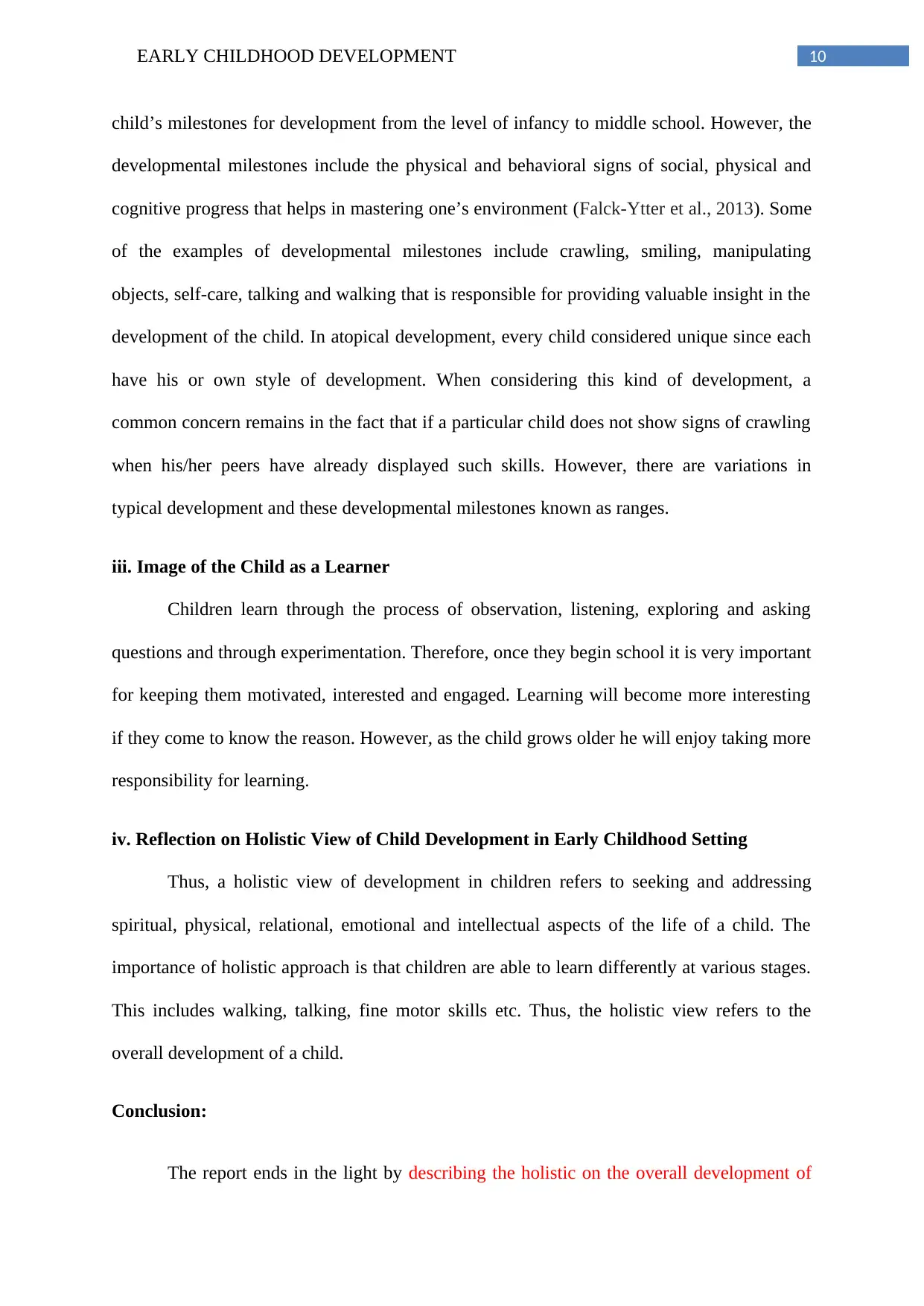
10EARLY CHILDHOOD DEVELOPMENT
child’s milestones for development from the level of infancy to middle school. However, the
developmental milestones include the physical and behavioral signs of social, physical and
cognitive progress that helps in mastering one’s environment (Falck-Ytter et al., 2013). Some
of the examples of developmental milestones include crawling, smiling, manipulating
objects, self-care, talking and walking that is responsible for providing valuable insight in the
development of the child. In atopical development, every child considered unique since each
have his or own style of development. When considering this kind of development, a
common concern remains in the fact that if a particular child does not show signs of crawling
when his/her peers have already displayed such skills. However, there are variations in
typical development and these developmental milestones known as ranges.
iii. Image of the Child as a Learner
Children learn through the process of observation, listening, exploring and asking
questions and through experimentation. Therefore, once they begin school it is very important
for keeping them motivated, interested and engaged. Learning will become more interesting
if they come to know the reason. However, as the child grows older he will enjoy taking more
responsibility for learning.
iv. Reflection on Holistic View of Child Development in Early Childhood Setting
Thus, a holistic view of development in children refers to seeking and addressing
spiritual, physical, relational, emotional and intellectual aspects of the life of a child. The
importance of holistic approach is that children are able to learn differently at various stages.
This includes walking, talking, fine motor skills etc. Thus, the holistic view refers to the
overall development of a child.
Conclusion:
The report ends in the light by describing the holistic on the overall development of
child’s milestones for development from the level of infancy to middle school. However, the
developmental milestones include the physical and behavioral signs of social, physical and
cognitive progress that helps in mastering one’s environment (Falck-Ytter et al., 2013). Some
of the examples of developmental milestones include crawling, smiling, manipulating
objects, self-care, talking and walking that is responsible for providing valuable insight in the
development of the child. In atopical development, every child considered unique since each
have his or own style of development. When considering this kind of development, a
common concern remains in the fact that if a particular child does not show signs of crawling
when his/her peers have already displayed such skills. However, there are variations in
typical development and these developmental milestones known as ranges.
iii. Image of the Child as a Learner
Children learn through the process of observation, listening, exploring and asking
questions and through experimentation. Therefore, once they begin school it is very important
for keeping them motivated, interested and engaged. Learning will become more interesting
if they come to know the reason. However, as the child grows older he will enjoy taking more
responsibility for learning.
iv. Reflection on Holistic View of Child Development in Early Childhood Setting
Thus, a holistic view of development in children refers to seeking and addressing
spiritual, physical, relational, emotional and intellectual aspects of the life of a child. The
importance of holistic approach is that children are able to learn differently at various stages.
This includes walking, talking, fine motor skills etc. Thus, the holistic view refers to the
overall development of a child.
Conclusion:
The report ends in the light by describing the holistic on the overall development of
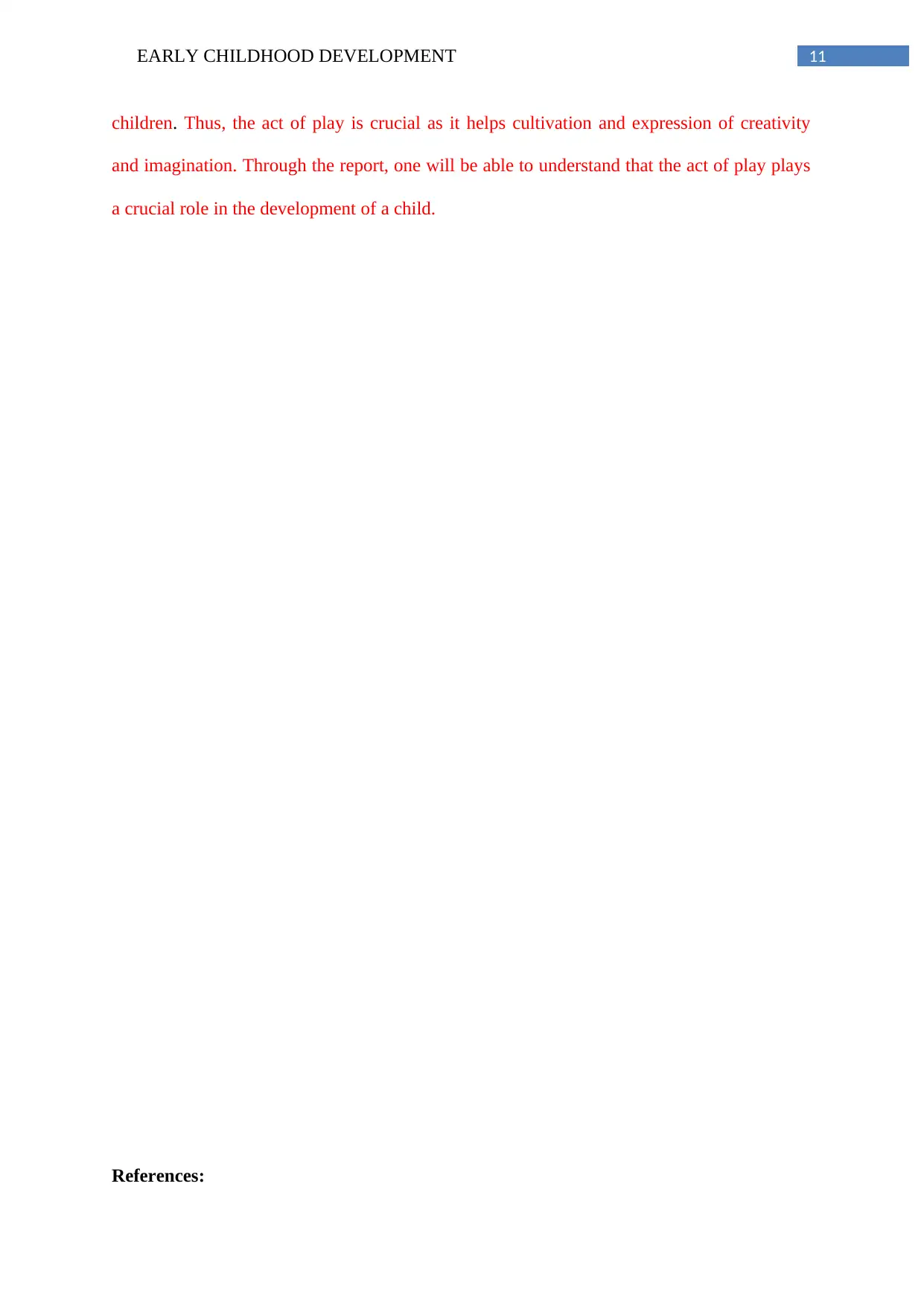
11EARLY CHILDHOOD DEVELOPMENT
children. Thus, the act of play is crucial as it helps cultivation and expression of creativity
and imagination. Through the report, one will be able to understand that the act of play plays
a crucial role in the development of a child.
References:
children. Thus, the act of play is crucial as it helps cultivation and expression of creativity
and imagination. Through the report, one will be able to understand that the act of play plays
a crucial role in the development of a child.
References:
⊘ This is a preview!⊘
Do you want full access?
Subscribe today to unlock all pages.

Trusted by 1+ million students worldwide
1 out of 14
Related Documents
Your All-in-One AI-Powered Toolkit for Academic Success.
+13062052269
info@desklib.com
Available 24*7 on WhatsApp / Email
![[object Object]](/_next/static/media/star-bottom.7253800d.svg)
Unlock your academic potential
Copyright © 2020–2025 A2Z Services. All Rights Reserved. Developed and managed by ZUCOL.





